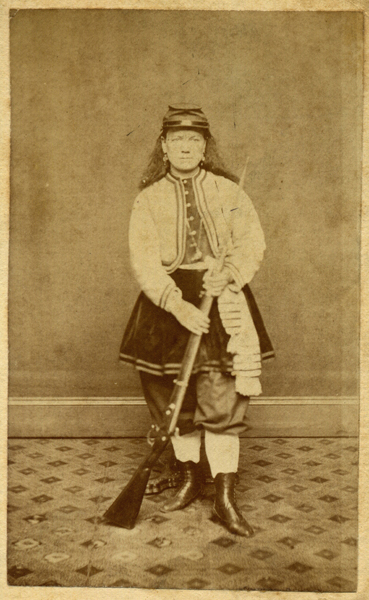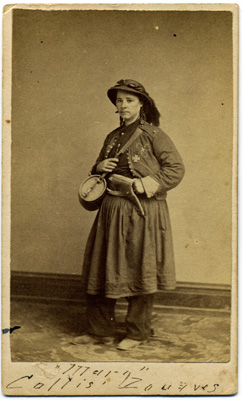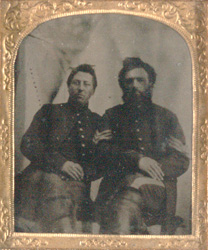
Dr Mary Walker
Gender Benders: Figure 1
Subject: Dr. Mary Walker
Maker: Elliott and Fry (London, England)
Genre: Studio portrait
Process: Carte de visite
Date: Circa 1866
Collection: Greg French
A staunch advocate of women’s rights, Dr. Mary Edwards Walker (1832-1919) was one of the first American women to go to medical school; , during the Civil War, she also became one of the first women to serve as a surgeon for the military, operating on wounded Union soldiers as well as tending civilians on both sides. She served with such distinction that she became the first woman to earn the Congressional Medal of Honor, which she wears here on her left shoulder. Dr. Walker was also a daring believer in the reform of women’s clothing: In this photograph she wears pants (then worn only by men) and a comfortable tunic that allowed the ease of movement needed for the active life of a doctor, then almost universally a man’s profession, while posing in front of a mirror to celebrate her femininity, symbolized by her long hair.

Miss Major Pauline Cushman
Gender Benders: Figure 2
Subject: Miss Major Pauline Cushman
Maker: E. and H. T. Anthony (New York)
Genre: studio portrait
Process: carte de visite, albumen print
Date: 1864-66
Collection: Greg French
Pauline Cushman (1833-1893) was born Harriet Wood in New Orleans and grew up in Grand Rapids, Michigan. She began a theatrical career in Louisiana in 1851 with “Pauline Cushman” as a stage name. During the Civil War, she became a spy for the Union, supposedly dressing as a man to infiltrate Confederate lines. Cushman narrowly escaped execution once when caught. Granted the honorary rank of major by General James Garfield (later president), after the war she toured and lectured in uniform as “Miss Major Pauline Cushman.” For more on Cushman’s exploits, see Pauline Cushman: Spy of the Cumberland (2006), by William J. Christen; for a contemporary (1865) account, see Life of Pauline Cushman, by F. L. Sarmiento.

Kady Brownell
Gender Benders: Figure 3
Subject: Kady Brownell
Maker: photographer unknown
Genre: studio portrait
Process: carte de visite, albumen print
Date: 1861-65
Collection: Greg French
Kady Brownell (1842-1915) was born in South Africa, in the camp of an officer of the British army, where she became used to military life. Around 1860, he immigrated to Providence, Rhode Island, where she worked in a factory and fell in love with the man she married, Robert Brownell. When Robert enlisted in a Rhode Island regiment, Kady insisted on joining him. She learned to shoot, use the sword, and bear the regimental flag. For a contemporary account of how she participated bravely in the battles of Bull Run and New Bern, see Women of the War: Their Heroism and Self-sacrifice (1866), by Frank Moore, pages 54-64. Brownell was the only woman in the Civil War to receive military discharge papers and, eventually, a veteran’s pension.

Mary Tebe
Gender Benders: Figure 4
Subject: Mary Tebe
Maker: R. W. Addis (Washington, DC)
Genre: studio portrait
Process: carte de visite, albumen print
Date: circa 1865
Collection: Greg French
Mary Tebe (also known as Marie or Mary Tepe, French Mary, and Zouave Mary) was a vivandiere with Pennsylvania’s 114th Regiment, Collis’ Zouaves. Zouaves were units in the Civil War that modeled their uniforms on French Algerian troops; as a vivandiere, Mary Tebe was a paid member of the regiment who served in many support roles, but especially as a nurse on and off the battlefield. Here, she wears a uniform modeled on that of Collis’ Zouaves; she carries her cask to administer water or spirits to wounded soldiers, and she wears the Kearny Cross that she was awarded for her bravery at the battle of Fredricksburg. Tebe also served at Gettysburg. For a contemporary description of Zouave Mary, see Four Brothers in Blue, by Robert Goldthwaite Carter, pages 281-3.

Albert Cashier and unknown sergeant
Gender Benders: Figure 5
Subject: Albert Cashier and unknown sergeant
Maker: photographer unknown
Genre: studio portrait
Process: tintype
Date: circa 1865
Collection: The Gilder Lehrman Collection
Albert Cashier (1843-1915), seated on the left, emigrated from Ireland to America as Jennie Hodgers. In 1862, Hodgers assumed the name Albert Cashier to enlist in the 95th Illinois infantry, serving through the war undiscovered and fighting in many battles. For half a century after the war, Cashier maintained an identity as a man, living in Saunemin, a small town in Illinois, drawing a military pension. When Cashier’s biological identity as female was revealed after an accident, he was forced to wear a dress, but former comrades rallied to him to ensure he kept his pension and was buried in his uniform. For a deposition in that case, see here. Cashier’s career is documented in They Fought Like Demons: Women Soldiers in the Civil War, by De Anne Blanton and Lauren Cook.
Frances Clalin Clayton, aka Jack Williams
Gender Benders: Figure 6
Subject: Frances Clalin Clayton, aka Jack Williams
Maker: Samuel Masury (Boston)
Genre: studio portrait
Process: carte de visite, albumen print
Date: circa 1865
Collection: Greg French
Frances Clalin Clayton (misidentified as Celetin on the back of this photo) was one of possibly hundreds of women who passed as men to fight in the Civil War. She adopted the name Jack Williams to join her husband, Elmer Clayton, when he enlisted in the Union army. She served in both the artillery and cavalry (her uniform here), and fought in several battles, including Fort Donelson and Stones River, where Elmer was killed right in front of her, but she stepped over him and kept on fighting. For a book about Clayton and other gender-bending warriors, see They Fought Like Demons: Women Soldiers in the Civil War, by De Anne Blanton and Lauren Cook.
